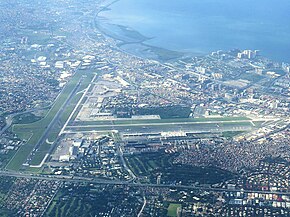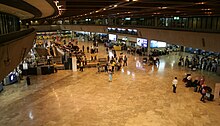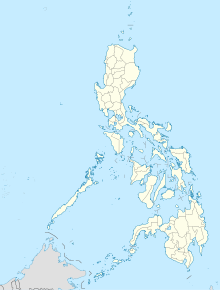Bandar Udara Internasional Ninoy Aquino
Bandar Udara Internasional Ninoy Aquino Paliparang Pandaigdig ng Ninoy Aquino | |||||||||||||||
|---|---|---|---|---|---|---|---|---|---|---|---|---|---|---|---|
 | |||||||||||||||
 | |||||||||||||||
| Informasi | |||||||||||||||
| Jenis | Publik / Militer | ||||||||||||||
| Pemilik/Pengelola | Manila International Airport Authority | ||||||||||||||
| Melayani | Wilayah Manila Raya | ||||||||||||||
| Lokasi | Parañaque dan Pasay, Metro Manila, Filipina | ||||||||||||||
| Dibuka | 1948 | ||||||||||||||
| Maskapai penghubung | |||||||||||||||
| Zona waktu | PHT (UTC+08:00) | ||||||||||||||
| Ketinggian dpl | 23 mdpl | ||||||||||||||
| Koordinat | 14°30′30″N 121°01′11″E / 14.50833°N 121.01972°E | ||||||||||||||
| Situs web | www | ||||||||||||||
| Peta | |||||||||||||||
 | |||||||||||||||
Lokasi di Manila, Filipina | |||||||||||||||
| Landasan pacu | |||||||||||||||
| |||||||||||||||
| Statistik (2022) | |||||||||||||||
| |||||||||||||||
Bandar Udara Internasional Ninoy Aquino (BUINA /ˈnaɪə/ NA-yah, locally /nɑː.ˈiː.jə/ na-EE-yah; pelafalan Tagalog: [ˈnɐʔia]; Filipina: Paliparang Pandaigdig ng Ninoy Aquino; IATA: MNL, ICAO: RPLL), awalnya dikenal sebagai Bandar Udara Internasional Manila (BUIM), merupakan nama bandara yang terletak di Manila, Filipina. Bandara ini merupakan bandara terbesar di Filipina. Bandara ini terletak di perbatasan Kota Pasay dan Kota Parañaque. Pada tahun 2007 bandara ini melayani 20.467.627 penumpang.
Terminal
[sunting | sunting sumber]Terminal 1
[sunting | sunting sumber]
The development of the Manila International Airport was finally approved through the promulgation of Executive Order No. 381, which authorized the airport's development. In 1973, a feasibility study/airport master plan was done by Airways Engineering Corporation through a US$29.6 million loan from the Asian Development Bank. The Detailed Engineering Design of the New Manila International Airport Development Project was done by Renardet-Sauti/Transplan/F.F. Cruz Consultant while the terminal's Detailed Architectural Design was prepared by Leandro Locsin's L.V. Locsin and Associates.[2]
In 1974, the detailed designs were adopted by the Philippine Government and was subsequently approved by the Asian Development Bank on September 18, 1975. Actual work on the terminal began during the second quarter of 1978. The terminal was completed in 1981 and had a size of 67,000 square meters with a design capacity of 4.5 million passengers per year.[3] It currently serves all non-Philippine Airlines and non-Cebu Pacific international flights. In 1989, a Master Plan Review recommended the construction of two new terminals (NAIA 2 and NAIA 3), as well as many other facility improvements.[2]
The terminal reached capacity in 1991, when it registered a total passenger volume of 4.53 million. Since 1991, the terminal has been over capacity and has been recording an annual average growth rate of 11%,[2] but improvements to the airport increased its capacity to 6 million passengers yearly.[4] It has 18 air bridges and services 33 airlines (as of May 2011). Interestingly enough, the building does not have a Gate 8 and a Gate 13. Compared with international terminals in other Asian countries, Terminal 1 has consistently ranked at the bottom due to limited and outdated facilities, poor passenger comfort, and crowding (the Terminal has been operating above designed capacity for decades now).[5] In this regard, transport authorities plan to give Terminal 1 a makeover; the plans were approved by President Benigno Aquino III. The makeover and upgrade includes the expansion of the arrival area, addition of parking spaces, and improvement of other terminal facilities.[6]
The Transportation and Communications Department previously announced that as soon as Terminal 3 becomes fully operational, Terminal 1 would be rehabilitated into an "Airport City", with the intention of Cebu Pacific Air to convert Terminal 1 into an exclusive terminal for their aircraft.[7] This terminal handles all international flights except those operated by Cebu Pacific, Philippine Airlines, PAL Express, Zest Airways, and All Nippon Airways.
The rehabilitation of Terminal 1 will be completed by November 2014.[8]
Terminal 2 (Centennial Terminal)
[sunting | sunting sumber]Terminal kedua, NAIA-2, yang terletak di Old MIA Road, selesai pada tahun 1998 dan mulai beroperasi pada tahun 1999. Teminal itu dinamakan Centennial Terminal dalam rangka memperingati seratus tahun (centennial) deklarasi kemerdekaan Filipina. Terminal yang berluas 75.000 meter persegi awalnya dirancang oleh Aéroports de Paris menjadi terminal domestik, tetapi desain kemudian dimodifikasi untuk mengakomodasi penerbangan internasional.[9] Terminal ini memiliki kapasitas 2,5 juta penumpang per tahun di sayap internasional dan 5 juta di sayap nasionalnya, dimungkinkan untuk menampung sembilan juta penumpang per tahun jika diperlukan.[9]
Terminal 2 secara eksklusif digunakan oleh Philippine Airlines untuk penerbangan domestik dan internasional. Terminal ini dibagi menjadi dua sayap: Sayap Utara, untuk penerbangan internasional, dan Sayap Selatan, yang menangani operasi domestik. Saat ini Terminal 2 memiliki 12 garbarata. Ada beberapa kafe dan restoran yang tersebar di seluruh pos-keamanan terminal. Ada juga bagian bebas bea kecil di sayap utara. Kebutuhan untuk dua terminal lainnya diusulkan oleh Rencana Induk Ulasan dari bandara yang dilakukan pada tahun 1989 oleh Aéroports de Paris (ADP). Penelitian ini difasilitasi melalui hibah dari Pemerintah Prancis. Tinjauan tersebut menelan biaya 2,9 juta franc Prancis dan telah disampaikan kepada Pemerintah Filipina untuk evaluasi pada tahun 1990.[10]
In 1991, the French government granted a 30 million franc soft loan to the Philippine government, which was to be used to cover the Detailed Architectural and Engineering Design of the NAIA Terminal 2. ADP completed the design in 1992 and in 1994, the Japanese Government granted an 18.12 billion yen soft loan to the Philippine Government to finance 75% of the terminal's construction costs and 100% of the supervision costs. Construction of the terminal began on December 11, 1995, and was formally turned over to the government of the Philippines on December 28, 1998.
Terminal 3
[sunting | sunting sumber]The third terminal of the airport, Terminal 3 or NAIA-3, is the newest and biggest terminal in the NAIA complex, wherein construction started in 1997. The terminal is one of the most controversial projects in the Philippines in that the government has become involved with legal battles, red tape, and arbitration cases in both the United States and Singapore, as well as technical and safety concerns which delayed its opening several times.[11] The terminal 3 is built on a 63.5-hectare lot that sits on Villamor Air Base. The terminal building has a total floor area of 182,500 m², having a total length of 1.2 kilometers. A four-level shopping mall connects the terminal and parking buildings. The parking building has a capacity of 2,000 cars while the outdoor parking area has a capacity of 1,200 cars. The terminal is capable of servicing 33,000 passengers daily at peak or 6,000 passengers per hour.
Its apron area has a size of 147,400 m², 34 air bridges, 20 contact gates with the ability of servicing 28 planes at any given time. The terminal has 70 flight information terminals, 314 display monitors, with 300 kilometers of fiber optic I.T. cabling. It also has 29 restroom blocks. The departure area has five entrances all equipped with X-ray machines with the final security check having 18 X-ray machines. Its baggage claim has 7 large baggage carousels, each with its own flight display monitor.[9]
The terminal officially opened to selected domestic flights from July 22, 2008 (initially Cebu Pacific only, then Philippine Airlines' subsidiaries Air Philippines and PAL Express), with Cebu Pacific international flights using it from August 1, 2008. All international operations, except for those from PAL, are intended to operate from Terminal 3 in the future, originally proposed to move in fourth quarter of 2010,[12] however domestic carriers Cebu Pacific and Airphil Express (then Air Philippines) remained the only tenants for the first two years of its operation. The vast majority of international flights still operate from Terminal 1, with the exception of All Nippon Airways being the first foreign-based carrier to operate out of Terminal 3 started in February 27, 2011.
Terminal 4 (Manila Domestic Passenger Terminal)
[sunting | sunting sumber]
The Manila Domestic Passenger Terminal, also known as NAIA Terminal 4,[13] is host to all domestic flights within the Philippines that are operated by AirAsia Zest and Tigerair Philippines, among others. Although it's intended to be a domestic airport, AirAsia Zest hosts most of its international flights as well. There are no jet bridges and passengers walk to and from the aircraft or are occasionally bussed. Twenty-six check-in counters are located in the terminal. The departure hall has the seating capacity for 969 people at a time. Several food stores and a book and magazine stall are also available. Five baggage carousels are located in the terminal whilst domestic airline offices, banks, restaurants and a grocery store are also located right beside the domestic passenger terminal.[14] The Domestic Terminal on the old Airport Road was built in 1948 and is located near the north end of Runway 13/31. An old hangar has since been annexed to the terminal.
Airbus A380
[sunting | sunting sumber]NAIA is one two airports in the Philippines that meet the infrastructure requirements for the Airbus A380 (the other is Clark International Airport). As of July 2013, no commercial flights are operating using this aircraft however it is an airport that provides MRO services conducted by Lufthansa Technik Philippines. On October 11, 2007, NAIA hosted the début of the Airbus A380 in the Philippines, after test aircraft MSN009 (registered as F-WWEA) landed on Runway 24. The test flight demonstrated that the A380 could land on existing runways in Asia and that the primary international airport of the Philippines can support aircraft as large as the A380.[15]
Maskapai
[sunting | sunting sumber]Penumpang
[sunting | sunting sumber]Kargo
[sunting | sunting sumber]Transportasi darat
[sunting | sunting sumber]Antar-terminal
[sunting | sunting sumber]The Manila International Airport Authority runs a shuttle bus system which connects all four terminals for the convenience of passengers who have onward connections on flights departing from another terminal. Shuttle buses run every fifteen minutes during daytime hours, but passengers are required to clear immigration and customs to use the system.
Philippine Airlines operates an airside shuttle service between Terminals 2 and 3 for passengers connecting to onward PAL Express flights and vice-versa.
Koneksi eksternal
[sunting | sunting sumber]Bus dan jeepney
[sunting | sunting sumber]Nine bus routes serve the airport from various points in Metro Manila: eight which go through Epifanio de los Santos Avenue (EDSA), and one via Circumferential Road 5 (C-5):
| Rute bus yang melayani NAIA | ||||||||||||||||||||||||||||||||||||||||||||||||||
|---|---|---|---|---|---|---|---|---|---|---|---|---|---|---|---|---|---|---|---|---|---|---|---|---|---|---|---|---|---|---|---|---|---|---|---|---|---|---|---|---|---|---|---|---|---|---|---|---|---|---|
|
All four terminals are also served by local jeepney routes serving Parañaque and Pasay.
Kereta
[sunting | sunting sumber]
The airport is connected, albeit indirectly, by rail: Baclaran station of the Manila Light Rail Transit System and Nichols station of the Philippine National Railways both serve the airport complex. An MIAA-operated shuttle bus also connects Terminal 3 to the Taft Avenue MRT Station.
In the future, with the extension of the existing Yellow Line, a new station, Manila International Airport station, is set to connect the airport, albeit still indirectly, to the LRT. A four-station spur extension of the Yellow Line, directly connecting Terminal 3 to Baclaran, is also proposed.
Jalan raya
[sunting | sunting sumber]The NAIA Expressway or NAIA Skyway connects NAIA/Nichols Exit of Metro Manila Skyway and Andrews Avenue in front of Terminal 3. It would soon be extended to Domestic Road, linking with Terminal 4 (Domestic Terminal), and NAIA Road, linking with Terminal 2, before reaching Roxas Boulevard and Coastal Road. Terminal 3 is served by the Nichols Exit of South Luzon Expressway, while Terminal 1 is served by Ninoy Aquino Avenue from Roxas Boulevard-NAIA Road.
Referensi
[sunting | sunting sumber]- ^ "Ninoy Aquino International Airport Passenger and Flight Statistics from 2014 to 2022" (PDF). Manila International Airport Authority. January 25, 2023. Diakses tanggal March 7, 2023.
- ^ a b c Airport: Terminal 1[pranala nonaktif permanen] Manila International Airport Authority Diarsipkan 2006-04-14 di Wayback Machine. Accessed September 7, 2006
- ^ "TERMINAL 1". Diarsipkan dari versi asli tanggal 2007-10-14. Diakses tanggal 2014-01-17.
- ^ "Salinan arsip". Diarsipkan dari versi asli tanggal 2013-02-10. Diakses tanggal 2014-01-17.
- ^ Reviews of Manila Ninoy Aquino Airport with Passenger reviews about Manila Ninoy Aquino Airport standards airlinequality.com.
- ^ [1]
- ^ This has yet to occur or commence.Cebu Pacific eyeing 'Airport City'--DOTC – Inquirer.net, Philippine News for Filipinos Diarsipkan 2010-11-18 di Wayback Machine. globalnation.inquirer.net.
- ^ "RENOVATIONS OF NAIA TERMINAL 1 EXPECTED TO COMPLETE BY NOVEMBER 2014". Philippine Flight Network. Diakses tanggal 21 November 2013.
- ^ a b c airport-tech
- ^ Airport : Terminal 1[pranala nonaktif permanen] Manila International Airport Authority Diarsipkan 2006-04-14 di Wayback Machine. Diakses 7 September 2006
- ^ GMANews.TV – NAIA 3 inspected for Monday opening – report – Nation – Official Website of GMA News and Public Affairs – Latest Philippine News – BETA. gmanes.tv. Accessed June 28, 2008.
- ^ Bright future for rural banks – Business Mirror Diarsipkan 2012-03-09 di Wayback Machine. Accessed May 14, 2009.
- ^ "About NAIA Terminal 4". Manila International Airport Authority. Diarsipkan dari versi asli tanggal 2014-02-22. Diakses tanggal June 28, 2012.
- ^ "Domestic Terminal". Diarsipkan dari versi asli tanggal 2008-04-25. Diakses tanggal 2014-01-17.
- ^ AFP: Airbus super jumbo visits Philippines to show it is ready for Asia, Agence France-Presse, October 11, 2007
Pranala luar
[sunting | sunting sumber]- Ninoy Aquino International Airport
- Manila International Airport Authority
- NAIA - MIAA Website[pranala nonaktif permanen] (Diakses 22 Me 2007)
Kesalahan pengutipan: Ditemukan tag <ref> untuk kelompok bernama "note", tapi tidak ditemukan tag <references group="note"/> yang berkaitan




